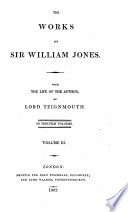 | Thomas Maurice - Coins, Ancient - 1800 - 492 pages
...not be fo ancient as the monumental characters in the caverns of Jarafandha, that the fquare Chaldaic letters, in which moft Hebrew books are copied, were...with the Indian and Arabian characters: that the. Phenician, from which the Greek and Roman alphabets were formed by various changes and inverfions,... | |
 | Asiatick Society (Calcutta, India) - Asia - 1801 - 580 pages
...characters in the caverns of Jarasandha, that the fquare Chaldaich letters, in .which moft Hebreio books are copied, were originally the fame, or derived...both with the Indian and Arabian characters. That the Phenidan, from which the Greek and Roman alphabets were formed by various changes and inverfions, had... | |
 | John Shore Baron Teignmouth - 1807 - 488 pages
...be fo ancient as the monumental characters in the caverns of Jarafandba, that the fquare Chaldaick letters, in which moft Hebrew books are copied, were...both with the Indian and Arabian characters: that the Phenician, from which the Greek and Roman a!T phabets were formed by various changes and inverfions,... | |
 | Sir William Jones - 1807 - 480 pages
...be fo ancient as the monumental characters in the caverns of Jarafandba, that the fquare Cbaldaick letters, in which moft Hebrew books are copied, were...both with the Indian and Arabian characters: that the Pherucian, from which the Greek and Roman alphabets were formed by various changes and inverfions,... | |
 | Sir William Jones - 1807 - 554 pages
...prototype, both with the Indian and Arabian characters, there can be little doubt ; and it is probable that the Phoenician, from which the Greek and Roman alphabets were formed, had a similar origin. The deities adored in India, were worshipped under different names in Old Greece... | |
 | William Jones - 1807 - 534 pages
...prototype, both \vith the Indian and Arabian characters, there can be little doubt ; and it is probable that the Phoenician, from which the Greek and Roman alphabets were formed, had a similar origin. The deities adored in India, were worshipped under different names in Old Greece... | |
 | Philomathic institution - 1824 - 522 pages
...originally the same, or derived from the same prototype, both with the Indian and Arabian characters ; and that the Phoenician, from which the Greek and Roman alphabets were formed, by various changes and inversions had a similar origin, there can be little doubt." I will venture to add, that whatever arguments... | |
 | 1848 - 524 pages
...letters, in which most Hebrew books are copied, were originally the same, or derived from the same prototype, both with the Indian and Arabian characters...Roman alphabets were formed by various changes and inversions, had a similar origin, there can be little doubt ; and the inscriptions at Canarah seem... | |
| |